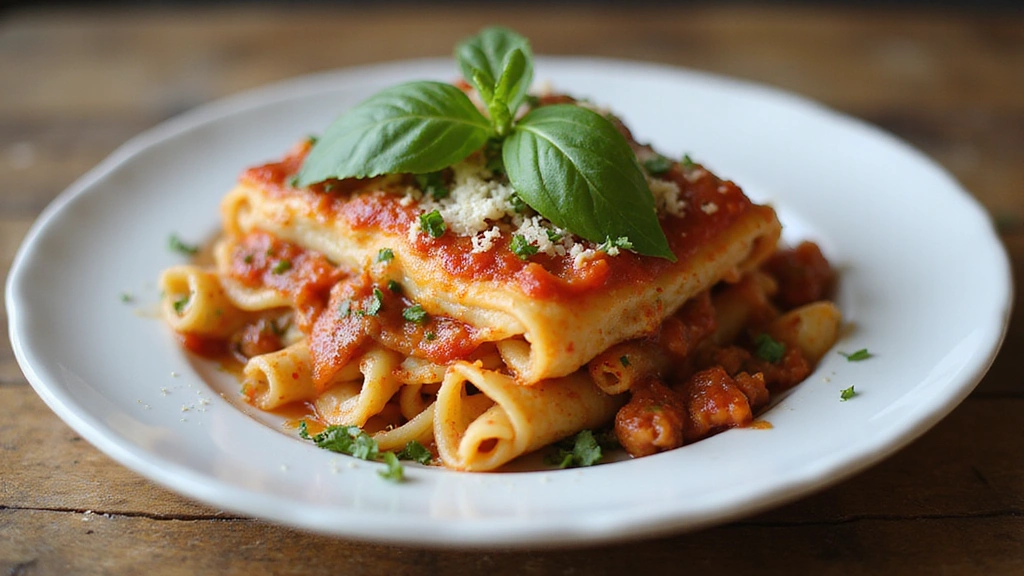Homemade lasagna noodles transform a simple dish into a culinary masterpiece.
The silky texture of freshly made pasta elevates the richness of traditional lasagna.
I first experienced the magic of homemade noodles during a family gathering, where every bite was savored.
With a little patience and care, you can create restaurant-quality lasagna at home.
This recipe is perfect for those who appreciate the art of cooking and are willing to invest time in creating something truly special.
The History and Cultural Significance
• Lasagna Noodles Recipe traces its origins to Ancient Rome, where it was originally created by layering thin sheets of dough with sauces and cheeses.
• The dish evolved over decades as tomatoes were introduced to Italian cuisine, eventually becoming the beloved version we know today.
• In Italy, this dish traditionally appears at festive celebrations, symbolizing warmth and togetherness.
• While many variations exist across different regions, the authentic version maintains a thin, tender noodle that sets it apart from imitations.
Recipe Overview
Nutritional Information (per serving)
Essential Equipment Guide
Pasta Machine: A pasta machine is crucial for rolling out the dough to the perfect thickness, ensuring even cooking and texture. Alternatives include a rolling pin, but it requires more effort and skill. Look for a machine with adjustable settings for different thicknesses.
Large Pot: A large pot is essential for boiling the noodles without overcrowding them, which can cause them to stick together. Any deep pot will work, but one with a wide diameter is preferable.
Flour Sifter: A flour sifter ensures a smooth, lump-free dough by evenly distributing the flour. If a sifter is unavailable, a fine-mesh strainer can be used as an alternative.
Ingredients
For the Noodles
|
|
| Amount | Ingredient | Notes |
|---|---|---|
| 2 cups | all-purpose flour | sifted for smooth texture |
| 3 large | eggs | room temperature |
| 1 teaspoon | salt | enhances flavor |
| 1 tablespoon | olive oil | adds richness and moisture |
Preparation Methods
Kneading: Kneading is essential for developing gluten in the dough, which gives the noodles their structure and bite. Knead the dough until it is smooth and elastic, about 10 minutes, using the heel of your hand to push and fold.
Resting the Dough: Allowing the dough to rest is crucial for relaxing the gluten, making it easier to roll out. Wrap the dough in plastic wrap and let it rest at room temperature for at least 30 minutes.
Rolling and Cutting: Use a pasta machine or rolling pin to achieve an even thickness, which is vital for uniform cooking. Start with the widest setting and gradually move to thinner settings, dusting with flour to prevent sticking.
Step 1: Prepare Ingredients

Gather all ingredients and equipment needed for the recipe.
Ensure eggs are at room temperature for best results.
Sift flour onto a clean work surface to prevent lumps.
Have a pasta machine or rolling pin ready for use.
Step 2: Make the Dough

Create a mound of flour on your work surface and make a well in the center.
Add eggs, salt, and olive oil into the well.
Use a fork to gradually incorporate flour into the eggs.
Continue mixing until a shaggy dough forms.
Step 3: Knead the Dough

Turn the dough out onto a floured surface and begin kneading.
Use the heel of your hand to push and fold the dough repeatedly.
Knead for about 10 minutes until the dough is smooth and elastic.
Wrap the dough in plastic wrap and let it rest for 30 minutes.
Step 4: Roll Out the Dough

Divide the rested dough into four equal pieces.
Flatten one piece slightly and pass it through the pasta machine at the widest setting.
Fold and pass it through again, reducing the thickness setting each time.
Repeat until the dough is smooth and the desired thickness is achieved.
Step 5: Cut the Noodles

Lay the rolled-out dough sheets on a floured surface.
Use a sharp knife or pasta cutter to slice the sheets into desired noodle width.
Dust the cut noodles with flour to prevent sticking.
Arrange noodles on a clean towel to dry slightly.
Step 6: Boil the Noodles

Fill a large pot with water and bring to a boil.
Add a generous amount of salt to the boiling water.
Carefully add noodles to the pot, stirring gently to prevent sticking.
Cook for 2-3 minutes until al dente, then drain.
Step 7: Assemble the Lasagna

Preheat your oven to 375°F (190°C).
Layer cooked noodles with your choice of sauce and fillings in a baking dish.
Ensure even distribution of ingredients for consistent flavor.
Top with cheese and cover with foil for baking.
Step 8: Bake the Lasagna

Place the assembled lasagna in the preheated oven.
Bake for 20 minutes covered, then remove foil.
Continue baking for an additional 10 minutes until cheese is golden and bubbly.
Allow lasagna to cool slightly before serving.
Critical Timing and Temperature Guide
Rolling the Dough: Roll the dough as soon as it has rested for 30 minutes. Ensure it doesn't dry out by covering unused portions with a damp cloth.
Boiling Noodles: Boil noodles for 2-3 minutes only to ensure they remain firm. Overcooking can result in mushy noodles.
Baking Lasagna: Bake at 375°F (190°C) for a total of 30 minutes. Look for bubbling cheese as an indicator of doneness.
Pro Tips for Lasagna Noodles Recipe
• Ingredient Selection: Use high-quality, fresh eggs and flour for the best texture and flavor.
• Preparation Secret: Let the dough rest longer for easier rolling and better texture.
• Temperature Management: Keep your kitchen environment cool to prevent the dough from becoming sticky.
• Texture Enhancement: Roll the dough to a consistent thickness to ensure even cooking.
• Flavor Layering: Add herbs to the dough for an aromatic twist.
• Make-Ahead Strategies: Prepare and freeze noodles in advance; thaw before boiling.
• Restaurant-Quality Finishing Touches: Grate fresh Parmesan cheese over the top before serving.
• Equipment Optimization: Regularly clean your pasta machine to ensure smooth operation.
Troubleshooting Common Issues
• Texture Too Dense: Caused by insufficient kneading or too much flour. Knead until smooth and elastic, and measure flour accurately.
• Noodles Sticking Together: Often due to overcrowding in the pot. Stir noodles gently and cook in batches if necessary.
• Uneven Cooking: Results from uneven dough thickness. Roll out dough uniformly for consistent results.
• Dough Breaking: Indicates the dough is too dry. Add a small amount of water or oil and knead until cohesive.
• Flavors Unbalanced: Caused by improper seasoning. Taste and adjust seasoning in sauces before layering.
• Burnt Top: Occurs from over-baking. Cover with foil if the top browns too quickly during baking.
Variations and Regional Differences
• Neapolitan Style: Uses a meat ragu and ricotta cheese for a richer flavor profile.
• Northern Italy: Incorporates béchamel sauce instead of ricotta, offering a creamier texture.
• Sicilian Lasagna: Includes boiled eggs and peas, adding a unique texture and flavor.
• Vegetarian Lasagna: Replaces meat with layers of roasted vegetables for a lighter option.
Food Science Behind the Recipe
• Gluten Development: Kneading helps develop gluten, providing structure and elasticity to the noodles.
• Egg Emulsion: Eggs act as an emulsifier, binding the flour and enhancing the dough's richness.
• Starch Gelatinization: Cooking the noodles causes starches to gelatinize, creating a tender, chewable texture.
Frequently Asked Questions
What's the most common mistake people make when preparing lasagna noodles? Overworking the dough, leading to tough noodles. Knead until just smooth and elastic.
How can I prevent noodles from sticking together? Cook in batches and use ample water with frequent stirring.
Can I use whole wheat flour? Yes, but it may require more hydration and yield a denser texture.
What's the best way to store unused noodles? Dry completely and store in an airtight container or freeze for later use.
How do I achieve consistent noodle thickness? Use a pasta machine and adjust settings gradually to ensure even rolling.
Can I add flavors to the dough? Yes, incorporating herbs or spices can add a unique twist to the noodles.
Should I salt the boiling water? Yes, salting the water seasons the noodles, enhancing overall dish flavor.
Is it necessary to use a pasta machine? While not essential, it greatly aids in achieving even thickness and texture.
Serving and Presentation Guide
• Traditional Presentation: Serve lasagna in a large baking dish, cut into squares for easy serving.
• Individual Servings: Use ramekins or small dishes for personal portions, adding a touch of sophistication.
• Family Style: Serve directly from the baking dish at the table, fostering a communal dining experience.
• Garnished Presentation: Top each serving with fresh basil leaves and a sprinkle of Parmesan for a vibrant finish.
Conclusion
Creating homemade lasagna noodles is a rewarding culinary endeavor that elevates a classic dish.
With patience and practice, you'll master the techniques needed to impress family and friends.
Embrace the art of pasta-making and enjoy the satisfaction of crafting a truly exceptional lasagna.

